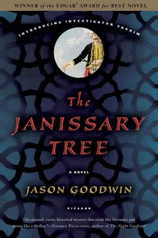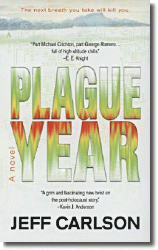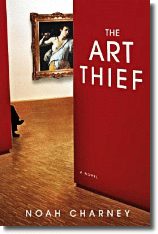 Jason Goodwin's Edgar Award–winning series set in Istanbul at the end of the Ottoman Empire--The Janissary Tree, The Snake Stone, and coming in 2009, The Bellini Card--features Investigator Yashim: detective, polyglot, chef, eunuch.
Jason Goodwin's Edgar Award–winning series set in Istanbul at the end of the Ottoman Empire--The Janissary Tree, The Snake Stone, and coming in 2009, The Bellini Card--features Investigator Yashim: detective, polyglot, chef, eunuch.Here Goodwin explores some casting options for a cinematic adaptation of the books:
Orientalist painters in the 19th century fell over themselves to capture the Ottoman Empire on canvas. They painted the mosques and domes, the palaces and bazaars, and of course the naked odalisques, reclining with their pipes. They captured the tilework and the black eunuchs, the costume and the artefacts of an imperial civilisation that was, visually, utterly stunning. Here’s a curious thing: no-one has ever done it on screen.Learn more about Jason Goodwin and his work at his website and blog.
But let’s face it: who’s man enough to play my central character, Yashim the Investigator?
He’s invisible. He’s active. He’s calm - and smart.
And he’s a eunuch.
I put this very question on my blog (the bellinicard.wordpress.com) and the answer was: Tony Shalhoub. He’s a versatile Lebanese American actor whose roots are properly Ottoman, like Yashim. The good news for Mr. Shalhoub is that Yashim doesn’t have a squeaky voice – and even gets involved with women.
Yashim's great friend is Count Palewski, an exiled Pole who also happens to be the ambassador to the Sublime Porte in Istanbul. He’s dry but charming, a drinker, a voracious reader who dabbles with the violin. Bill Nighy, please.
Come back, Peter Lorre. You were the most sinuous and untrustworthy villain in movie history, and I was thinking of you when I wrote about the dodgy French archaeologist, Lefèvre. And do bring Claude Raines with you: he’d make a splendid sultan.
You don’t have to be camp to play Preen, the transvestite dancer – but Julian Clary has the right air of vulnerability. Julian Clary in a black wig.
The girls? The Validé, for a start: the sultan’s proud and acerbic French-born mother. A natural beauty, even in her seventies. Would Catherine Deneuve mind aging herself for the part? Or Tilda Swinton – a little line of chalk beneath the cheese.A Russian countess – extravagantly beautiful, and brimming with youthful curiosity. Juliette Binoche, if she’d just step down from The Unbearable Lightness of Being - or Lauren Bacall, best of all, if she could take some time after shooting The Big Sleep.
In The Snake Stone a lovely French girl, Amelie, with a steel streak. Not Audrey Tautou of the eponymous movie, but Uma Thurman, maybe.
Telly Savalas as the bull-headed Seraskier of The Janissary Tree.
Sydney Greenstreet for the Soup Master.
All of it set in Istanbul and – lately – Venice. Clear the streets, please!
--Marshal Zeringue













